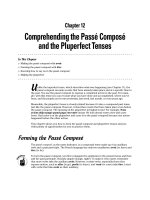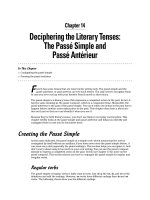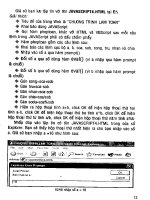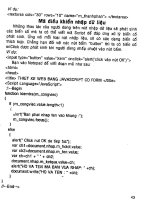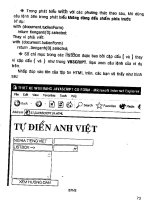Lecture E-Commerce - Chapter 21: Java Script (part III)
Bạn đang xem bản rút gọn của tài liệu. Xem và tải ngay bản đầy đủ của tài liệu tại đây (435.32 KB, 80 trang )
CSC 330 E-Commerce
Teacher
Ahmed Mumtaz Mustehsan
GM-IT CIIT Islamabad
Virtual Campus, CIIT
COMSATS Institute of Information Technology
T3-Lecture-2
JavaScript
Part-III
T2-Lecture-08
T2-Lecture-7
Mustehsan
Ahmed Mumtaz
www.w3schools.com
1-2
Objectives
JS
Strings (contd…)
JS Numbers
JavaScript Operators
JavaScript Math Object
JavaScript Dates
JavaScript Booleans
JavaScript Comparison and Logical Operators
JavaScript If...Else Statements
JavaScript loop statements ( for, while, do/while)
JavaScript Best Practices
3
T2-Lecture-7
Ahmed Mumtaz Mustehsan
www.w3schools.com
Replacing Content
The
replace() method replaces a specified value with
another value in a string:
Example
str = "Please visit Microsoft!"
var n = str.replace("Microsoft","W3Schools");
The replace() method can also take a regular
expression as the search value.
T2-Lecture-7
Ahmed Mumtaz Mustehsan
www.w3schools.com
1-4
Convert to Upper Case
A string
is converted to upper case with the
method toUpperCase():
Example
var txt = "Hello World!";
// String
// txt1 is txt converted to upper
var txt1 = txt.toUpperCase();
T2-Lecture-7
Ahmed Mumtaz Mustehsan
www.w3schools.com
1-5
Convert to Lower Case
A string
is converted to lower case with the
method toLowerCase():
Example
var txt = "Hello World!";
// String
// txt1 is txt converted to lower
var txt1 = txt.toLowerCase();
T2-Lecture-7
Ahmed Mumtaz Mustehsan
www.w3schools.com
1-6
Convert a String to an Array
A string
is converted to an array with the built in
method string.split():
Example
var txt = "a,b,c,d,e"
txt.split(",");
txt.split(" ");
txt.split("|");
T2-Lecture-7
Ahmed Mumtaz Mustehsan
// String
// Split on commas
// Split on spaces
// Split on pipe
www.w3schools.com
1-7
Special Characters
In JavaScript, strings are written as characters inside single or
double quotes.
JavaScript will misunderstand this string:
"We are the so-called "Vikings" from the north.“
The string will be chopped to "We are the so-called ".
To solve this problem, you can place a backslash (\) before the
double quotes in "Vikings":
"We are the so-called \"Vikings\" from the north.“
The backslash is an escape character. The browser treats the
next character as an ordinary character.
The escape character (\) can be used to insert apostrophes, new
lines, quotes, and other special characters into a string.
T2-Lecture-7
Ahmed Mumtaz Mustehsan
www.w3schools.com
1-8
Special Characters..
Use of Escape Character
T2-Lecture-7
Ahmed Mumtaz Mustehsan
www.w3schools.com
1-9
Strings Can be Objects
Normally,
JavaScript strings are primitive values,
created from literals: var firstName = "John"
But strings can also be defined as objects with the
keyword new: var firstName = new String("John")
Example
var x = "John";
var y = new String("John");
typeof(x) // returns String
typeof(y) // returns Object
T2-Lecture-7
Ahmed Mumtaz Mustehsan
www.w3schools.com
110
Strings Can be Objects…
Don't
create String objects. They slow down execution
speed, and produce nasty side effects:
Example
var x = "John";
var y = new String("John");
(x === y) // is false because x is a string and y is
an object.
T2-Lecture-7
Ahmed Mumtaz Mustehsan
www.w3schools.com
111
String Properties and Methods
Primitive values, like "John", cannot have properties or methods
(because they are not objects).
But with JavaScript, methods and properties are also available
to primitive values, because JavaScript treats primitive values as
objects
Properties:
length
prototype
constructor
Methods:
charAt()
charCodeAt()
concat()
fromCharCode()
indexOf()
T2-Lecture-7
Ahmed Mumtaz Mustehsan
www.w3schools.com
112
String Properties and Methods…..
lastIndexOf()
localeCompare()
match()
replace()
search()
slice()
split()
substr()
substring()
toLowerCase()
toUpperCase()
toString()
trim()
valueOf()
T2-Lecture-7
Ahmed Mumtaz Mustehsan
www.w3schools.com
113
JS Numbers
JS Numbers
JavaScript
has only one type of number.
Numbers can be written with, or without decimals.
Example
var x = 3.14; // A number with decimals
var y = 34;
// A number without decimals
Extra large or extra small numbers can be written with
scientific (exponent) notation:
Example
var x = 123e5; // 12300000
var y = 123e-5; // 0.00123
T2-Lecture-7
Ahmed Mumtaz Mustehsan
www.w3schools.com
115
JavaScript Numbers are Always 64-bit Floating
Point
Unlike
many other programming languages,
JavaScript does not define different types of numbers,
like integers, short, long, floating-point etc.
JavaScript numbers are always stored as double
precision floating point numbers, following the
international standard.
This format stores numbers in 64 bits, where the
number (the fraction) is stored in bits 0 to 51, the
exponent in bits 52 to 62, and the sign in bit 63:
T2-Lecture-7
Ahmed Mumtaz Mustehsan
www.w3schools.com
116
Precision
Integers (numbers without a period or exponent notation) are
considered accurate up to 15 digits.
Example
var x = 999999999999999; // x will be 999999999999999
var y = 9999999999999999; // y will be
10000000000000000
The maximum number of decimals is 17, but floating point
arithmetic is not always 100% accurate:
Example
var x = 0.2 + 0.1;
// x will be 0.30000000000000004
To solve the problem above, it helps to multiply and divide:
Example
var x = (0.2 * 10 + 0.1 * 10) / 10;
// x will be 0.3
T2-Lecture-7
Ahmed Mumtaz Mustehsan
www.w3schools.com
117
Hexadecimal
JavaScript interprets numeric constants as hexadecimal if they
are preceded by 0x.
Example
var x = 0xFF;
// x will be 255
Never write a number with a leading zero.
Some JavaScript versions interprets numbers as octal if they are
written with a leading zero.
By default, Javascript displays numbers as base 10 decimals.
The toString() method is used to output numbers as base 16
(hex), base 8 (octal), or base 2 (binary).
Example
var myNumber = 128;
myNumber.toString(16); // returns 80
myNumber.toString(8);
// returns 200
myNumber.toString(2);
// returns 10000000
T2-Lecture-7
Ahmed Mumtaz Mustehsan
www.w3schools.com
118
Numbers Can be Objects
Normally JavaScript numbers are primitive values created from
literals: var x = 123
But numbers can also be defined as objects with the keyword new: var
y = new Number(123)
Example
var x = 123;
var y = new Number(123);
typeof(x);
// returns number
typeof(y);
// returns object
Don't create Number objects. They slow down execution speed,
and produce nasty side effects:
Example
var x = 123;
var y = new Number(123);
(x === y) // is false because x is a number and y is an object.
T2-Lecture-7
Ahmed Mumtaz Mustehsan
www.w3schools.com
119
Number Properties
MAX_VALUE
MIN_VALUE
NEGATIVE_INFINITY
POSITIVE_INFINITY
NaN
prototype
constructor
Number properties belongs to JavaScript's number object
wrapper called Number.
These properties can only be accessed
as Number.MAX_VALUE.
Using num.MAX_VALUE, where num is a variable, expression,
or value, will return undefined.
T2-Lecture-7
Ahmed Mumtaz Mustehsan
www.w3schools.com
120
Number Methods
toExponential()
toFixed()
toPrecision()
toString()
valueOf()
Number methods can be used on any number, literal, variable, or
expression:
Example
var x = 123;
x.valueOf();
// returns 123
(123).valueOf();
// returns 123
(100+23).valueOf();
// returns 123
T2-Lecture-7
Ahmed Mumtaz Mustehsan
www.w3schools.com
121
JavaScript Operators
JavaScript Operators
=
is used to assign values.
+ is used to add values.
The assignment operator = is used to assign values to
JavaScript variables.
The arithmetic operator + is used to add values
together.
Example
Assign values to variables and add them together:
y = 5;
z = 2;
x = y + z;
The result of x will be: 7
T2-Lecture-3
Ahmed Mumtaz Mustehsan
www.w3schools.com
123
JavaScript Arithmetic Operators
Arithmetic
operators are used to perform arithmetic
between variables and/or values.
Given that y=5, the table below explains the
arithmetic operators:
Operator
Description
Example
Result
Result
+
Addition
x=y+2
y=5
x=7
-
Subtraction
x=y-2
y=5
x=3
*
Multiplication
x=y*2
y=5
x = 10
/
Division
x=y/2
y=5
x = 2.5
%
Modulus (division remainder)
x=y%2
y=5
x=1
++
Increment
x = ++y
y=6
x=6
x = y++
y=6
x=5
--
Decrement
x = --y
y=4
x=4
x = y--
y=4
x=5
T2-Lecture-3
Ahmed Mumtaz Mustehsan
www.w3schools.com
124
JavaScript Assignment Operators
Assignment
operators are used to assign values to
JavaScript variables.
Given that x=10 and y=5, the table below explains the
assignment operators:
T2-Lecture-3
Operator
Example
Same As
Result
=
x=y
x=y
x=5
+=
x += y
x=x+y
x = 15
-=
x -= y
x=x-y
x=5
*=
x *= y
x=x*y
x = 50
/=
x /= y
x=x/y
x=2
%=
x %= y
x=x%y
x=0
Ahmed Mumtaz Mustehsan
www.w3schools.com
125

